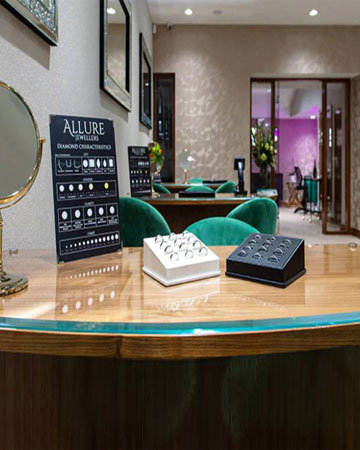Our exquisite range of diamonds come in all shapes and sizes, and we take pride in our wide variety of designs. Choosing the shape of your diamond or gemstone is perhaps the first thing to think about when looking for an engagement ring. This decision will have the biggest impact on the overall look of the piece, and paired with the 4C's is certainly an important consideration. In our guide below, we will look at the most popular diamond shapes so you know exactly what to look for when shopping for an engagement ring.
What Is a Diamond Shape?
A diamond shape refers to the physical outline or silhouette of a diamond when viewed from above. Common diamond shapes include round, princess, cushion, emerald, and pear, each with its own unique characteristics and proportions. The shape of a diamond can significantly influence its appearance and brilliance, making it an important factor to consider when selecting a diamond for jewellery.

Round Brilliant Diamonds
The most popular of all diamond shapes is the Round, or Brilliant cut. It is classic and timeless in appearance, and cut in such a way that maximises light dispersion - a good choice for optimising the sparkle factor. Round diamonds are more expensive per carat compared to fancy shapes due to two main reasons: high demand and lower yield. The cutting process of round diamonds results in more wastage of the rough stone, making the cost per carat higher.
Explore Round Brilliant Diamond Rings
Oval Diamonds
A flattering shape on most fingers, the Oval is a more modern choice than Brilliant, whilst still being elegant and classic in style. The symmetrical and elongated cut can make the diamond appear larger for its carat weight. Oval cut diamonds typically have 58 facets, including a large flat table on top and a pointed culet at the bottom.
Cushion Cut Diamonds
A square or rectangular silhouette with rounded corners, the Cushion shape works nicely with most ring settings. The facets are typically larger and make the dispersion of light appear as flashes rather than the sparkle of a brilliant-cut diamond. While generally less brilliant than round diamonds, cushion-cut diamonds often have better fire, which is part of their appeal.
Princess Cut Diamonds
Like the Cushion, a Princess cut is square in appearance but with cleaner, more contemporary lines. The second most popular shape, its symmetry and modern feel make it the diamond shape of choice for many. The princess-cut diamond, often labelled as a square or rectangular modified brilliant cut by the GIA, is a popular choice due to its flexibility to work in almost any style of ring, similar to round-cut diamonds.
Explore Princess Cut Diamond Rings
Radiant Cut Diamonds
Radiant gems boast a rectangular silhouette with recognisable trimmed corners; an amalgamation of the elegance of the emerald cut and sparkle of a Brilliant diamond. The radiant cut was designed by Henry Grossbard in the late 1970s. He created a cutting technique that brought together the best aspects of emerald and round diamond cuts, allowing the invention of radiant diamonds.
Asscher Cut Diamonds
Square in appearance with square cut corners. Its steeper facets and deep crown allow an Asscher diamond to maximise its sparkle. The modern Asscher cut diamond is similar to a square emerald cut. It typically has larger step facets, a higher crown, and a smaller table. Like the emerald cut, the Asscher cut has cropped corners. However, because an asscher is square, the cropped corners give the asscher cut a somewhat octagonal shape.
Explore Asscher Cut Diamond Rings
Heart Shape Diamonds
Perhaps the most iconic and recognisable shape of love and romance. When selecting a heart, it's important to consider symmetry as a critical characteristic. The two halves of the heart should be identical, with a sharp and distinct cleft between the two lobes and slightly rounded wings as they curve down to the point.
Explore Heart Shape Diamond Rings
Emerald Cut Diamonds
Perhaps the most iconic and recognisable shape of love and romance. When selecting a heart, it's important to consider symmetry as a critical characteristic. The two halves of the heart should be identical, with a sharp and distinct cleft between the two lobes and slightly rounded wings as they curve down to the point. While less fiery, the long lines and dramatic flashes of light give the emerald cut an elegant appeal. The shape was originally developed for the cutting of emeralds, thus the name.
Explore Emerald Cut Diamond Rings
Pear Shape Diamonds
Also known as the Teardrop, the Pear shape features characteristics of both the Brilliant and Marquise diamond. As with other elongated shapes, this is a flattering option for most finger shapes and makes for a stunningly unusual diamond. A pear-shaped diamond should have excellent or very good symmetry, with the pointed end lining up with the apex of the rounded end. The shoulders and wings should form uniform, symmetrical curves, and the rounded top should resemble a semi-circle.
Explore Pear Shape Diamond Rings
Marquise Cut Diamonds
This shape provides the largest surface area of all diamond shapes and, therefore, can make a stone seem larger for its carat weight. The Marquise is a brilliant cut gem and is contemporary in style. Like the oval diamond, the Marquise cut diamond's elongated shape can create the illusion of longer and slimmer fingers for the wearer.
Explore Marquise Cut Diamond Rings
Trillion Shape Diamonds
A triangular silhouette with a geometrical aesthetic, a Trillion (or Trilliant) diamond will have sides of equal length and a flat table. The term 'Trilliant diamond' combines the words 'Triangle' and 'Brilliant' to create a memorable name used within the diamond industry. 'Triangle' refers to the shape, while 'Brilliant' describes the angular faceting that gives the diamond its brightness.
Baguette Shape Diamonds
Featuring just 14 facets, this is the simplest of diamond shapes. Most commonly seen with a long rectangular silhouette, Baguette stones commonly play the supporting role in engagement ring design, sitting on the shoulder of the band. Featuring just 14 facets, Baguette stones are commonly used as side stones for engagement rings, eternity rings, or wedding bands.


